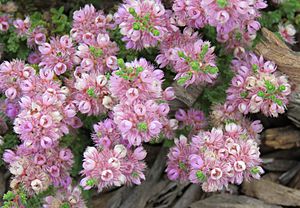Salt-loving featherflower facts for kids
Quick facts for kids Salt-loving featherflower |
|
|---|---|
 |
|
| V. halophila in the Royal Botanic Gardens, Cranbourne | |
| Scientific classification | |
| Genus: |
Verticordia
|
| Species: |
halophila
|
Verticordia halophila, often called the salt-loving featherflower, is a special plant found only in the south-west part of Western Australia. It's part of the myrtle family, Myrtaceae. This plant is a bushy shrub with small, thick leaves. It produces lovely red and pink flowers during spring.
Contents
What Does the Salt-Loving Featherflower Look Like?
The Verticordia halophila is a shrub that usually grows to be about 30 to 75 centimeters (12 to 30 inches) tall. It can spread out to be about 45 to 70 centimeters (18 to 28 inches) wide. It has a few main stems with many short, leafy branches.
The leaves on these side branches are small and packed closely together. They are thick and shaped like an egg, with a rounded end and a tiny point. These leaves are covered with very short, soft hairs. The leaves on the flowering stems are wider and almost round.
The Flowers of the Featherflower
The flowers of this plant have a nice scent. They grow in groups that look like spikes near the ends of the long flowering stems. Each flower sits on a very short stalk, about 0.5 to 1.0 millimeter long.
The part of the flower that holds the petals and sepals, called the floral cup, is shaped like a top. It is smooth and about 2.0 to 2.5 millimeters long. It has five small ribs and tiny green parts that bend outwards.
The sepals, which are like small leaves protecting the flower bud, are pink with a white fringe. They are about 4 to 5 millimeters long and have five or six hairy sections. They also have two ear-shaped, hairy parts on their sides. The petals are a pretty mauve-pink color and stand upright. They are about 3.5 to 4 millimeters long and have short, rough teeth along their top edge. The style, which is part of the flower's reproductive system, is about 5 to 5.5 millimeters long. It is curved and has short hairs near its purple tip.
This plant blooms from September to December. You can tell it apart from similar plants by its thick, crowded leaves, the tiny teeth on its petals, its purple-tipped style, and because it grows in salty places.
How the Salt-Loving Featherflower Got Its Name
The Verticordia halophila was first officially described by a scientist named Alex George in 1991. He published his description in a scientific journal called Nuytsia. The first samples of this plant were collected by Alex and Elizabeth George near Coorow in 1985.
The second part of its scientific name, halophila, comes from two Greek words. "Hals" means salt, and "-philus" means loving. So, "halophila" means "salt-loving." This name was chosen because the plant grows in salty environments, which is quite unusual for plants in its group.
Where the Salt-Loving Featherflower Lives
This type of verticordia usually grows in sandy and clay soils. It likes flat areas that are a bit salty, often found near the edges of salt lakes. You can find it growing in woodlands and shrublands. It is found in and around places like Coorow, Marchagee, and Lake Seabrook. These areas are part of the Avon Wheatbelt, Coolgardie, and Geraldton Sandplains regions in Western Australia.
Is the Salt-Loving Featherflower Protected?
The Western Australian Government's Department of Parks and Wildlife has classified Verticordia halophila as "not threatened." This means it is not currently at risk of disappearing.
Using the Salt-Loving Featherflower in Gardens
Some types of this plant are being grown in gardens, and they are doing very well. These bushy shrubs produce flowers that smell like honey. They usually bloom from October to March, but sometimes they can flower in other months too.

